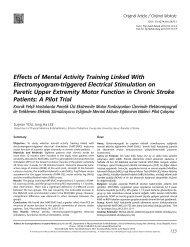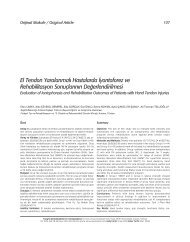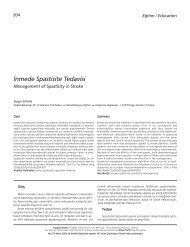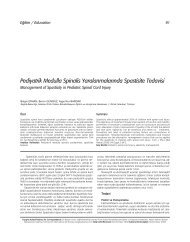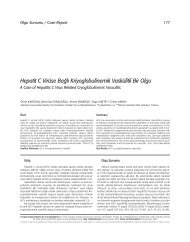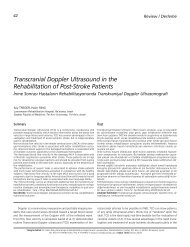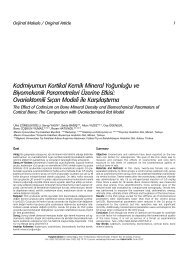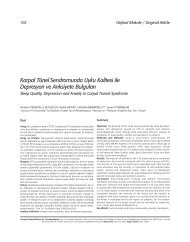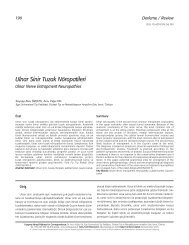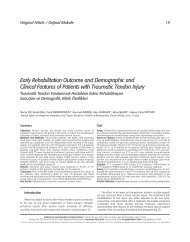‹nmeli Hastalarda Yaflflam Kalitesini Etkileyen ... - FTR Dergisi
‹nmeli Hastalarda Yaflflam Kalitesini Etkileyen ... - FTR Dergisi
‹nmeli Hastalarda Yaflflam Kalitesini Etkileyen ... - FTR Dergisi
You also want an ePaper? Increase the reach of your titles
YUMPU automatically turns print PDFs into web optimized ePapers that Google loves.
167<br />
23. Ulusal Fiziksel T›p ve Rehabilitasyon Kongresi / 23 rd National Physical Medicine & Rehabilitation Congress<br />
Türk Fiz Rehab Derg 2011:57Özel Say›; 1-334 /Turk J Phys Med Rehab 2011:57Suppl; 1-334<br />
P-025<br />
Pelvik Kosta; Olgu<br />
Saadet Deniz Demiral 1, Özer Gündüz 1, Ferda Karcebafl 1, Bahri Gümüfl 2<br />
1Suat Seren Gö¤üs Hastal›klar› ve Cerrahisi E¤itim ve Araflt›rma Hastanesi<br />
Fizik Tedavi ve Rehabilitasyon Bölümü, ‹zmir<br />
2Suat Seren Gö¤üs Hastal›klar› ve Cerrahisi E¤itim ve Araflt›rma Hastanesi<br />
Radyoloji Bölümü, ‹zmir<br />
Pelvik kosta veya pelvik dijit, kemi¤in nadir, benign geliflimsel anomalisidir. Bu tan›mlama ilk<br />
kez 1974 y›l›nda Sullivan ve Cornwell taraf›ndan yap›lm›flt›r. Embriyolojik geliflim s›ras›nda<br />
komflu yumuflak doku içinde geliflen kemik yap›d›r. T›bbi literatürde yer alan olgu say›s› azd›r.<br />
Ço¤unlukla tek tarafl›d›r ve asemptomatiktir, nadiren kalça a¤r›s› ve fonksiyonel yetmezli¤e<br />
yol açabilir. Genellikle, uygun pozisyonda al›nan direkt radyografiler tan›da yeterli olmakla birlikte,<br />
Bilgisayarl› Tomografi (BT) incelemesi ile yalanc› eklem yüzeyi daha iyi gösterilebilir.<br />
Posttravmatik myozitis ossifikans, heterotopik ossifikasyonlar, ekzostozlar ay›r›c› tan›da<br />
göz önünde bulundurulmal›d›r. Medikal tedaviye dirençli olgular d›fl›nda, ço¤unlukla cerrahi<br />
gerektirmez.<br />
Olgumuz 45 yafl›nda, erkek hasta sol kalçada lokalize, özellikle oturma, çorap giyme gibi<br />
durumlarda artan, yay›l›m göstermeyen a¤r› flikayeti ile poliklini¤imize baflvurdu. Efllik eden<br />
bel a¤r›s›, uyuflma yak›nmas› yoktu. Muayenede sol kalça fleksiyon ve eksternal rotasyonu<br />
a¤r›l› bulundu. Rutin laboratuar testleri, lomber ve sakroiliak muayene bulgular› normal<br />
olarak de¤erlendirildi.<br />
Hastan›n çekilen kalça radyografisinde spina iliaka anterior inferiordan, trochanter majore<br />
uzanan kemik kitle izlendi. BT ile de¤erlendirmede pelvisle yalanc› eklem oluflturan pelvik<br />
kosta anomalisi rapor edildi.<br />
Olgumuzda 10 günlük NSAII ve myorelaksan tedavi ile semptomlarda iyileflme elde edildi.<br />
Anahtar Kelimeler: Dijit, kosta, pelvik<br />
P-026<br />
Kronik Plantar Fasiit Tan›l› <strong>Hastalarda</strong> Ekstrakorporeal<br />
fiok Dalga Tedavisi (ESWT)'nin Etkinli¤i<br />
Osman Tüfekci<br />
Özel Konya Farabi Hastanesi Fiziksel T›p ve Rehabilitasyon Servisi, Konya<br />
AMAÇ: Plantar fasiit tedavisinde ekstrakorporeal flok dalga tedavisi (ESWT)'nin etkinli¤inin<br />
araflt›r›lmas›<br />
GEREÇ-YÖNTEM: Bu çal›flmada kronik plantar fasiitli hastalarda ESWT'nin etkinli¤inin<br />
araflt›r›lm›flt›r. Bu çal›flmaya en az 6 ayd›r topuk a¤r›s› olan ve di¤er fizik tedavi yöntemlerine<br />
cevap vermeyen 39 (27K, 12E) hasta al›nd›. Kad›n hastalar›n yafl ortalamas› 50,1 erkek hastalar›n<br />
ortalama yafl› 48,7 idi. Tüm hastalar›n ortalama yafl› ise 48,89 idi. Tüm hastalara ayn›<br />
uygulay›c› taraf›ndan ESWT yap›ld›. Tedavi sonras› hastalar ortalama 6,3 ay takip edildi.<br />
Hastalara rutin olarak 1000 flok dalga impulsu (s›kl›¤› 2 saniyede bir kez), enerji yo¤unlu¤u ise<br />
0.35 mJ/mm 2 olarak her seansta uyguland›. Tüm hastalara haftada bir kez tedavi yap›ld›.<br />
Tüm hastalara tedaviden hemen sonra ve tedavi sonras› 2.hafta, 1.ay, 3. ay ve 6. ay telefon ile<br />
ulafl›larak tedavini etkinli¤i sorguland›. <strong>Hastalarda</strong> tedavini etkinli¤i VAS, Roles and Maudsley<br />
skorlar›, American Orthopaedic Foot and Ankle Society (AOFAS) ankle and hindfoot score ile<br />
de¤erlendirildi. Tedavini etkinli¤i VAS de¤erinde %30'luk azalma olarak kabul edildi.<br />
BULGULAR: Dört seansl›k ESWT uygulamas› sonucunda %67'lik bir baflar›, tedavi sonras›<br />
ikinci haftada %70, 6. ay sonunda ise %81'lik bir baflar› elde edildi.<br />
SONUÇ: Plantar fasiit topuk a¤r›s›n›n en s›k nedenidir ve toplumda yaklafl›k %10 s›kl›¤›nda<br />
görülmektedir. Hastal›¤a travma, ayaktaki biyomekanik anormallikler, uygunsuz dar ayakkab›,<br />
fliflmanl›k, sürekli ayakta durmay› gerektiren ifllerin neden olabilece¤i bildirilmifltir. Radyolojik<br />
olarak kemiksel ç›k›nt› görülebilir. Bir çok tedavi seçene¤i vard›r. Bu hastalar›n büyük<br />
ço¤unlu¤u germe egzersizi, enjeksiyon, ayakkab› modifikasyonlar› gibi konservatif tedavi<br />
yöntemleri ile iyileflir. Plantar fasiitin klinik tan›s› genellikle kolayd›r ve Plantar fasiitin genel<br />
tedavi yaklafl›m› konservatiftir. Bu hastalar›n yaklafl›k %10'unda konservatif tedavi yetersiz<br />
kalmakta ve bazen cerrahi tedavi yöntemleri kullan›lmas›n› gerektirebilmektedir. Elde edilen<br />
bu sonuçlar ESWT' nin plantar fasiitin tedavisinde etkili bir yöntem oldu¤unu göstermektedir.<br />
Anahtar Kelimeler: Kalkeneal spur, ekstrakorporeal flok dalga tedavisi (ESWT), plantar fasiit<br />
P-025<br />
Pelvic Rib; Case Report<br />
Saadet Deniz Demiral 1, Özer Gündüz 1, Ferda Karcebafl 1, Bahri Gümüfl 2<br />
1 Suat Seren Chest Diseases Training and Research Hospital Department of<br />
Physical Therapy and Rehabilitation, Izmir<br />
2 Suat Seren Chest Diseases Training and Research Hospital,<br />
Department of Radiology, Izmir<br />
Pelvic rib or digit is uncommon and benign congenital anomaly. It has been defined as a bone<br />
tissue developed in soft tissue near the pelvis. It was first reported by Sullivan -Cornwell in<br />
1974. It’s usually unilateral and asymptomatic, but rarely causes hip pain and functional<br />
deficiency. Although direct radiography usually is sufficient for diagnosis, Computerized<br />
tomography (CT) would be better to show pseudo-articulations. In the differential<br />
diagnosis, post-traumatic myositis ossificans, heterotrophic ossifications and exostoses are<br />
important. Therapy is medical, but it rarely needs surgery.<br />
Our 45 year old patient had pain in his left hip increasing by sitting and wearing socks and<br />
etc. He didn’t suffer from back pain and numbness. On clinical examination, left hip flexion<br />
and external rotation were painful. Lumber and sacroilac examinations and routine blood<br />
tests were normal. Radiographic examination showed bone formation, prolonged<br />
from spina ilaca ant inf to thoracanter major. Pelvic rib was reported in CT which had<br />
pseudo- articulations. The symptoms of the patient were improved with NSAI and myorelaxating<br />
drugs in 10 days.<br />
Keywords: Digit, pelvic, rib<br />
P-026<br />
Efficiency of Extracorporeal Shock Wave Therapy (ESWT) for Patients<br />
Diagnosed with Chronic Plantar Fasciitis<br />
Osman Tüfekci<br />
Private Konya Farabi Hospital Physical Therapy and Rehabilitation Service, Konya<br />
OBJECTIVE: Research on efficiency of Extracorporeal Shock Wave Therapy (ESWT) in<br />
treatment of Plantar fasciitis<br />
MATERIALS-METHODS: This study deals with efficiency of ESWT in patients with chronic<br />
plantar fasciitis. 39 patients (27M, 12F) with heel pain of 6 months or longer duration and<br />
replied to no other physical treatment methods were included in the study. Average age of<br />
female patients was 50.1, it was 48.7 for male patients. Average age of all patients was 48.89.<br />
ESWT was performed for all the patients by the same practitioner. After the treatment,<br />
patients were followed up for 6,3 months on average. One thousand shock wave impulses<br />
(once in two seconds as a frequency) were applied to the patients in routine, while energy<br />
density of 0.35 mJ/mm 2 for each seance. All patients were treated once a week. All patients<br />
were questioned about the efficiency of treatment following the treatment and 2nd week, 1st<br />
month, 3rd month and 6th month after treatment on the phone. Treatment efficiency was<br />
evaluated with VAS, Roles and Maudsley scores, American Orthopaedic Foot and Ankle<br />
Society (AOFAS) ankle and hindfoot score for the patients. Having a decrease of 30% in VAS<br />
value was accepted as the efficiency of the treatment.<br />
RESULTS: 67% success for ESWT application for four seances, 70,6% success for the second<br />
week after treatment and 81% success for end of the month were obtained.<br />
CONCLUSIONS: Plantar fasciitis is the most common reason of heel pain and seen<br />
approximately with a frequency of 10% in population. It has been explained that trauma,<br />
biomechanical abnormalities of the foot, inappropriate narrow shoes, obesity, and tasks<br />
always requiring standing cause the disease. Osteophyte can be seen in radiology. There are<br />
lots of treatment options. Most patients recover with conservative treatment methods such<br />
as stretching exercises, injection, shoe modifications. Clinic diagnosis of plantar fasciitis is<br />
generally easy and usual treatment approach of plantar fasciitis is conservative.<br />
Conservative treatment is ineffective in 10% of the patients, and sometimes requires<br />
surgical treatment. Results demonstrate that ESWT is an effective method for treatment of<br />
plantar fasciitis.<br />
Keywords: Calcaneal spur, extracorporeal shock wave therapy (ESWT), plantar fasciitis



